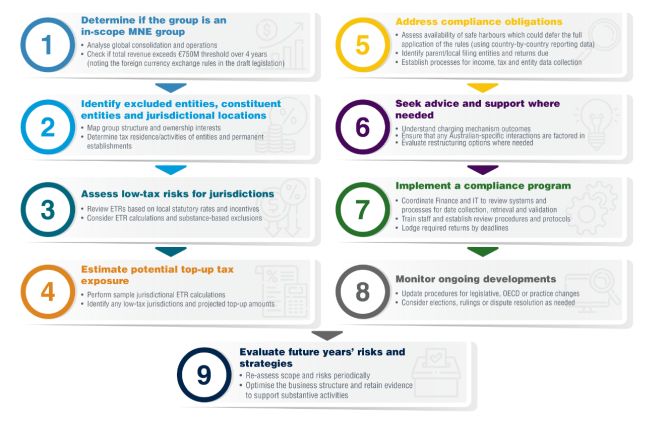The Australian government has released exposure draft legislation to implement key aspects of Pillar Two of the OECD/G20 international tax reforms1, which seek to ensure that multinational enterprises pay a global minimum 15 percent tax rate on income derived in jurisdictions where they operate.
This article provides an overview of the draft legislation and consultation paper and explains how the materials seek to implement the global minimum tax rules developed by the OECD, known as the GloBE Rules, as well as the "domestic minimum tax."
Australian taxpayers need to be familiar with the draft rules as the changes are expected to commence as early as 1 January 2024 for certain taxpayers.
The draft legislation consists of three bills and subordinate legislation in the form of rules:
- Taxation (Multinational—Global and Domestic Minimum Tax) Imposition Bill 2024 (the Imposition Bill)
- Taxation (Multinational—Global and Domestic Minimum Tax) Bill 2024 (the Assessment Bill)
- Taxation (Multinational—Global and Domestic Minimum Tax) Consequential Bill 2024 (the Consequential Bill)
- Taxation (Multinational—Global and Domestic Minimum Tax) Rules 2024 (the Rules)
Further, the Australian government released a consultation paper to seek feedback on how the Pillar Two rules interact with Australia's domestic rules, such as its hybrid mismatch rules, foreign hybrid mismatch rules, controlled foreign company (CFC) regime and foreign income tax offsets.
A&M Perspective – Australian tax impact
Under the Australian Pillar Two rules (as drafted), we note the following key considerations for both Australian outbound (Aus-headquartered) and inbound (overseas-headquartered) multinational groups:
- Application – The three Pillar Two
top-up taxes will broadly set in as follows:
- Income years starting on/after 1 January 2024 – for the income inclusion rule (IIR) (for Australian-headquartered and intermediate parents) and the domestic minimum tax (DMT) (for low-taxed Australian subsidiaries)
- Income years starting on/after 1 January 2025 – for the undertaxed payments rule (UTPR) (broadly, as a backstop mechanism to collect top-up tax that is uncollected elsewhere)
- Thresholds – Multinational groups with global consolidated revenue of €750 million may be subject to the new regime. Certain types of entities may be excluded (e.g., investment entities, sovereign wealth funds and not-for-profits).
- Safe harbours – Certain transitional period rules may apply to deem top-up tax for a jurisdiction to be zero for income years ending up to 30 June 2028. There are also permanent safe harbours allowing simplified calculations to be undertaken.
- Lodgements and payments – In-scope groups may need to lodge up to three new types of Australian tax returns. Lodgement (and any payment required) for these returns will generally be due 15 months after the end of the income year. An 18-month due date can apply in the first year.
- Penalties – Administrative penalties for failure to lodge have been increased to 500 times the base penalty amount (consistent with those that apply for significant global entities).
- Deductibility and franking credits – Payments of any top-up taxes (under the IIR, DMT or UTPR) will not be deductible in Australia. However, DMT will give rise to franking credits in the Australian entity's franking account.
The Pillar Two rules will require significant information gathering and planning effort (and cross-border coordination) to ensure compliance.
Overview of the GloBE Rules
Under Pillar Two of the OECD/G20 international tax package, the GloBE Rules ensure that large multinational enterprise (MNE) groups are subject to a minimum 15 percent effective tax rate (ETR) on income earned in market jurisdictions.
To determine in-scope MNE groups, we look at revenue over a four-year period based on the group's consolidated financial statements. Where the group's revenue meets or exceeds the €750 million threshold in at least two of the last four years, the GloBE Rules should apply.
The rules achieve the 15 percent ETR through an "income inclusion rule" (IIR) which allows jurisdictions to tax profits that have escaped tax and an "undertaxed payments rule" (UTPR) which denies deductions to entities to collect tax elsewhere in the world.
The rules also include a "domestic minimum tax" (DMT), allowing jurisdictions to directly impose tax in respect of low taxed Australian entities to achieve the minimum rate.
Key aspects of the Australian legislation
The bills establish the framework for applying the IIR, UTPR and DMT in Australia consistent with the GloBE Rules. Key elements include:
- Defining the scope of MNE groups and their constituent entities who are subject to the rules
- Identifying entities that are members of an MNE group excluded from the rules
- Calculating the ETR on a jurisdictional basis
- Imposing top-up tax via the DMT, IIR or UTPR where the ETR in a jurisdiction is below 15 percent
- Administrative requirements around returns, assessments and record keeping
Top-up tax under the IIR and DMT applies for income years starting on or after 1 January 2024, while the UTPR kicks in for income years starting on or after 1 January 2025.
Returns are required to be lodged by mid-2026 for taxpayers that are required to apply the rules from 1 January 2024. A transitional safe harbour rule may defer the full application of the rules to years ending after 30 June 2028.
The Rules are intended to be broadly consistent with the OECD materials released to date, including the GloBE Model Rules and Commentary as well as the additional Agreed Administrative Guidance and Safe Harbours.
Some further details of how the Rules are intended to operate are as follows:
Calculating the Jurisdictional ETR:
- Start with the financial accounting net income of each constituent entity, as shown on the group's consolidated financial statements.
- Adjustments are made to align this more closely with the tax base, such as for intra-group transactions, stock-based compensation, etc.
- Covered taxes include local income taxes and foreign withholding taxes, but exclude consumption taxes, transaction-based taxes, employment taxes and property taxes.
- Deferred tax assets/liabilities are included but capped at the minimum rate to prevent excess sheltering of non-routine profits.
- The adjusted income and taxes of entities in the same jurisdiction are aggregated to calculate that jurisdiction's ETR.
- Various five-year elections are available to adopt certain adjustments to the calculation of ETR.
Substance-based Income Exclusion:
- A carve-out percentage of payroll and tangible assets is excluded from the low-tax income inclusion base, focusing the rules on excess non-routine returns (subject to transitional rules until 31 December 2032).
- This aims to exclude a routine return commensurate with real economic activity from the GloBE taxing rights allocation.
Charging the Top-Up Tax:
- The IIR imposes tax on the ultimate or intermediate parent entity (UPE) based on its share of ownership in the low-taxed constituent entity.
- The UTPR will act as a backstop measure to the IIR, where any residual tax is allocated amongst cooperating jurisdictions. The details of the UTPR are currently left as a placeholder but the UPTR is expected to result in a denial of deductions based on their relative employees and tangibles assets based on OECD guidance.
- Australia's DMT allows direct collection of tax on low-taxed Australian income.
Special Calculations:
- Flow-through entities are located based on where they are created or required to apply the IIR/UTPR.
- Joint ventures and subsidiaries are separately assessed unless fully consolidated, to prevent splitting of ownership to avoid the payment of top-up tax.
Safe Harbours and Transitional Rules:
- Three safe harbours may apply to an MNE group to either defer the full application of their GloBE and DMT obligations or reduce the administrative burden of computing the top-up tax.
- Transitional rules are available to take into account tax attributes at the start of the first income year in which the GloBE rules apply to the MNE group.
Implementation details from an Australian tax perspective
The rules seek to work cooperatively with the agreed upon OECD GloBE Model Rules by aligning definitions, computations and the rule priority order with the internationally agreed approach. Significant administrative discretion has been delegated to Treasury to update the Rules.
While compliance obligations are substantial, administrative penalties for failure to lodge have been increased to 500 times the base penalty amount (consistent with those that apply for significant global entities) to encourage timely compliance.
Below are some details regarding how the Australian tax law is expected to interact with the GloBE Rules:
- Payment of top-up tax under the IIR, UTPR and DMT will not be deductible.
- However, as the DMT is a domestic tax, payment of the DMT will give rise to franking credits for relevant Australian corporate tax entities. Similarly, franking debits will arise where DMT is refunded. The government is still seeking views on the timing of when these franking credits and debits arise.
- Three types of returns are required to be given to the
Commissioner:
- A GloBE Information Return – a standardised return consistent with the OECD guidance
- An Australian GloBE Tax Return – contains information for the purpose of assessing IIR and UPTR top-up tax
- A DMT Return – contains information for the purpose of assessing DMT top-up tax
- Lodgement of these returns as well as payment of the top-up tax is due at the end of the 15th month following the end of the relevant income year, except for the first year which is extended to 18 months. The Commissioner does not have discretion to defer the time for lodgement of the GloBE Information Return but may defer the time for lodgement of the Australian GloBE Tax Return and DMT Return.
- Assessments of top-up tax payable under the IIR, UTPR and DMT are subject to an ATO review period of four years and can also be objected to, aligning with income tax returns.
- The head company of an Australian tax consolidated group will be primarily liable for the top-up tax of each entity in the group.
- The government's consultation paper contemplates that foreign income tax offsets and nominal allowable deductions under the CFC rules should be available for any DMT top-up tax paid in a foreign jurisdiction, but not in relation to the IIR or UTPR.
- The consultation paper also contemplates that amendments are required to the hybrid mismatch rules and foreign hybrid rules in order to disregard top-up taxes paid under a foreign jurisdiction's GLoBE and DMT rules.
Suggested Corporate Framework
Below is a suggested framework that a corporate group can use to assess the application of the Pillar Two rules and ensure compliance:

Footnote
1. International taxation – global and domestic minimum tax – primary legislation | Treasury.gov.au and International taxation – global and domestic minimum tax – subordinate legislation | Treasury.gov.au
Originally published by 17 April, 2024
The content of this article is intended to provide a general guide to the subject matter. Specialist advice should be sought about your specific circumstances.



